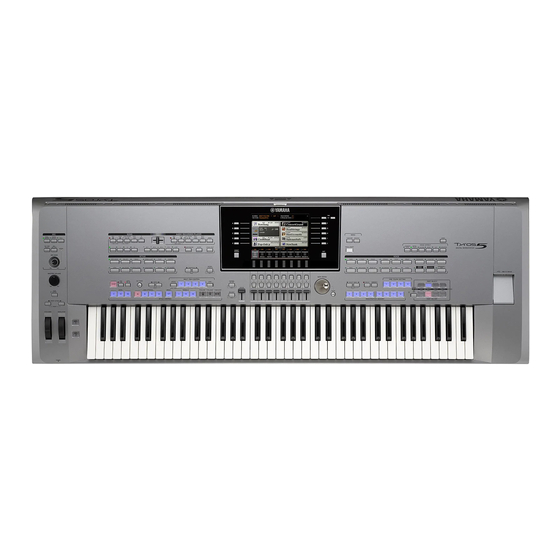
Summary of Contents for Yamaha Tyros Series
- Page 1 Manual: How to connect YAMAHA keyboards (Tyros, PSR) with SongBook+ Document-Revision 1.0.6...
-
Page 2: Table Of Contents
What are the benefits of connecting SongBook+ with the keyboard?......3 SongBook+ controls the keyboard ....................3 Keyboard controls SongBook+ ....................3 Compatible Yamaha keyboards .................. 3 How do I connect SongBook+ with my keyboard? ............4 Using the WiFi stick of Tyros 5 ....................5 Using a Bluetooth LE MIDI Adapter .................... -
Page 3: What Are The Benefits Of Connecting Songbook+ With The Keyboard
2 Compatible Yamaha keyboards Attention: For the new Yamaha Genos keyboard, you can find a separate manual named “How to connect YAMAHA Genos keyboards with SongBook+”. This manual shows how the settings are made on a Tyros 5. The configuration of other Tyros models or PRS keyboards is similar. -
Page 4: How Do I Connect Songbook+ With My Keyboard
3 How do I connect SongBook+ with my keyboard? SongBook+ has a MIDI monitor which can display received MIDI events. Using this, you can check the communication with the keyboard. Just open this window and have the keyboard send some MIDI signals to SongBook+, e.g. by pressing keys, by selecting a registration or playing a midi (song) file. -
Page 5: Using The Wifi Stick Of Tyros 5
3.1 Using the WiFi stick of Tyros 5 The UD-WL01 WiFi stick shipped with the Tyros 5 can be used to connect the iPad with the Tyros 5. The Tyros 5 can then act as a Wireless MIDI Server and SongBook+ is the Wireless MIDI Client. -
Page 6: Using A Bluetooth Le Midi Adapter
Pairing of the adapter in the Bluetooth settings of the iPad is not needed. SongBook+ has a “Bluetooth LE MIDI devices” function to establish the connection to the adapter. (e.g. Yamaha MD-BT01, Yamaha UT-BT01, QuiccoSound mi.1, Zivix PUC+) Note that the Bluetooth LE MIDI is supported only by iPad 3 or later. -
Page 7: Using Usb-Midi Directly To The Keyboard
3.3 Using USB-MIDI directly to the keyboard Keyboards with a USB to Host port can be connected using a USB printer cable. As the iPad doesn’t have a USB connection, you need an adapter (commonly called a camera connector) to connect the iPad with the USB cable. 3.4 Using a USB MIDI adapter Many USB to MIDI cables can be also used with the iPad. -
Page 8: Using A Midi Adapter That Can Be Connected Directly To Ipad
3.5 Using a MIDI adapter that can be connected directly to iPad You can also find MIDI cables that are designed for use with Apple iOS devices (iPad, iPhone, etc). For these cables, the camera connector is not needed. Note that only a few of these adapters can charge the iPad while it’s being used. Consider that feature when buying such an adapter. -
Page 9: Midi Settings In Songbook
1. Open the settings in SongBook+. 2. Select MIDI settings 3. Select channel 1. 4. Select the control mode “YAMAHA Tyros Registrations (with code)“. 5. When using the WiFi- Stick with Tyros 5, activate this setting. Page 9... -
Page 10: "Songbook+ Controls Keyboard" Method
5 ”SongBook+ controls keyboard“ Method Using this feature, SongBook+ can activate a registration bank from the current folder. If needed, it can also activate a specific registration from the 8 registrations contained in the bank. Attention: This method of remote control only works with Tyros 2 or newer, but not with Tyros 1 or keyboards of PSR series. -
Page 11: Midi Settings On Keyboard
5.2 MIDI settings on keyboard In order to select the registration by MIDI commands from SongBook+, the keyboard needs some corresponding MIDI settings. We assume here that the MIDI channel 1 is used to control the keyboard and that the iPad is connected to PORT 1 (MIDI A/USB 1/WLAN). -
Page 12: Link The Song In Songbook+ To The Keyboard Registration
5.3 Link the Song in SongBook+ to the keyboard registration Enter in the “Code” field the number of the corresponding registration bank as a 3-digit number. This will activate the first registration of that bank when you open a song in SongBook+. -
Page 13: "Keyboard Controls Songbook+" Method
6 “Keyboard controls SongBook+“ Method Using this feature, selecting a registration on the keyboard triggers SongBook+ to open the corresponding PDF file (to display the notes, chords, lyrics, etc.). This is done by including a midi (song) file in the registration to identify the desired file. The required MIDI files can be downloaded from the SongBook+ website using the link in chapter 6.2. -
Page 14: Midi Settings On Keyboard
6.1 MIDI Settings on keyboard In order to control SongBook+ using these small MIDI files, the keyboard must be configured accordingly. We assume here that the MIDI channel 1 is used to control SongBook+ and that the iPad is connected to PORT 1 (MIDI A/USB 1/WLAN). If you want to use another MIDI channel or another port, you need to specify it where needed. -
Page 15: Link The Song In Songbook+ To The Keyboard Registration
6.2 Link the Song in SongBook+ to the keyboard registration Download the prepared small MIDI files from the SongBook+ website: www.baum-software.ch/downloads/DummyFiles/YamahaDummyMidis.zip Extract the files from the zip file, and copy the necessary files to the same drive your registrations are on. We recommend you put these files in a subfolder called “SongBook”. First, add a 3-digit number to the “Code”... -
Page 16: Combine Both Methods
7 Combine both methods It is technically possible to combine both methods described above. But because to select songs in SongBook+ the registrations must be sorted by code, and to select songs in the keyboard you probably want the songs to be sorted by name, it doesn’t make much sense to combine both methods.







